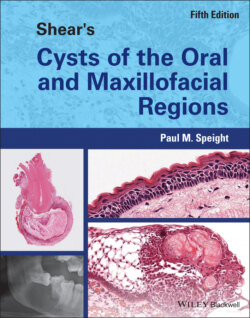Читать книгу Shear's Cysts of the Oral and Maxillofacial Regions - Paul M. Speight - Страница 59
Malignant Change in Radicular Cysts
ОглавлениеPrimary intraosseous squamous cell carcinoma is defined as a central lesion in the jaw bones, which cannot be categorised as any other type of carcinoma (Koutlas and Sloan 2022 ). To establish the diagnosis, an oral lesion that has invaded the jaws, or metastatic lesions to the jaw bones, must be excluded. Intraosseous carcinomas are derived from odontogenic epithelium and may arise de novo, with no identifiable precursor lesion, or may be preceded by an odontogenic cyst or a benign odontogenic tumour. In a review of the world literature, Thomas et al. (2001 ) were only able to identify 35 cases of de novo lesions, suggesting that the majority of intraosseous squamous carcinomas arise in a pre‐existing lesion and most probably arise in odontogenic cysts. Eversole et al. (1975 ) reviewed series of cases of central squamous cell carcinoma and found that 75% were associated with a cyst lining. In a detailed review of the literature, Gardner (1969 ) examined the evidence presented with each of 63 cases reported during the period 1889–1967 and concluded that 25 (39.7%) fulfilled the criteria for an origin from odontogenic cyst.
Bodner et al. (2011 ) reviewed 116 cases of primary intraosseous squamous cell carcinomas that had arisen in odontogenic cysts. Of these, 70 cases (60.3%) were associated with radicular or residual cysts, 19 (16.4%) with dentigerous cysts, and 16 (13.8%) with an odontogenic keratocyst. Only 1 lesion was found to be associated with a lateral periodontal cyst and 10 could not be classified. The majority of cases (92, 79.3%) were found in the mandible and there was a male : female ratio of 2 : 1.
Before the diagnosis of carcinoma arising from a cyst lining can be established, a number of alternative possibilities must be excluded (Bodner et al. 2011 ; Woolgar et al. 2013 ; Koutlas and Sloan 2021 ). It is possible that a benign cyst and the carcinoma may have developed independently adjacent to one another and ultimately fused in some parts. Careful questioning of the patient and clinical examination are necessary to exclude the possibility that the neoplasm arose primarily from the oral mucosa, or that it is a metastatic deposit in the jaw. A further possibility to be considered is that the lesion was initially an epithelial neoplasm that underwent secondary cystic change. To be certain of the diagnosis, histological evidence of frank squamous cell carcinoma directly in transition from a typical odontogenic cyst lining is regarded as the gold standard diagnostic criterion, but in some cases the malignancy may have overgrown and effaced the precursor lesion. It is also important not to overinterpret an inflamed or proliferating cyst lining as malignant. On occasions, the arcading epithelium of a radicular cyst may give a pseudoepitheliomatous appearance and islands of odontogenic epithelium in the wall are not uncommon. Attention to the cytology of the islands is helpful. Often the epithelium is bland and resembles squamous odontogenic tumour rather than the atypical epithelium of malignancy (Parmar et al. 2011 ; Chrcanovic and Gomez 2018a ).
Despite the undoubted examples that occur from time to time, the frequency of neoplastic change is exceptionally rare in relation to the large numbers of cysts that are seen. There is no evidence, however, that cyst epithelium is at particular risk and there is therefore no justification for regarding cysts as pre‐cancerous lesions. The pathogenesis of malignant change is not known, but some have speculated that it is induced by the long‐standing chronic inflammation (Bodner et al. 2011 ; Jain et al. 2013 ). This would explain the higher frequency of malignant change in radicular cysts, and is in keeping with the now well‐established association between carcinogenesis and inflammation (Crusz and Balkwill 2015 ).
